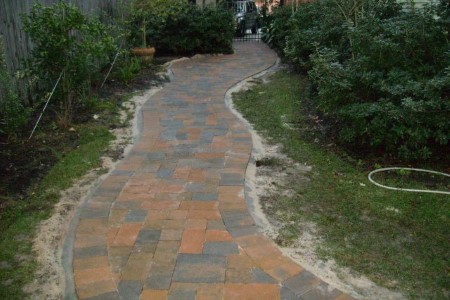Permeable Pavers - Their Role in Green Construction in Hammond

Permeable pavers in Hammond offer us the ability to create a hardscape surface that allows water to pour back into the water table. The purpose of this article is to share specific information about this material, which will allow the reader to understand the specifics of this product and to impact these details to your customers, particularly in reference to the role of Hammond permeable pavers in green design. Below is a general outline of the main points related to this subject, and it should be a quick and easy way to and to put some of the basic facts and figures at your fingertips. If you wish to print this outline, it will also be available on our website as well.
This overview looks at: some of the problems with hardscape surfaces the do not allow water to penetrate, Low Impact Design (or LID), and how it seeks to treat this problem, and some general information about how permeable pavers can accomplish this, in addition to stating how they conform to The Americans with Disabilites Standards, plus, some pointers on how these pavers can be used in LEED projects, and the areas in which they can be used for points.
Surfaces that do not permit the penetration of surface water cause two main problems:
- Overworked storm drains, causing excess, untreated water to run to rivers and lakes.
- 2. Suspended sediments and heavy metals run directly into storm drains without being filtered by the natural system.
Low Impact Development (LID): A design strategy with the goal of “maintaining and enhancing the pre-development hydrologic regime of urban and developing watersheds.†One of the primary objectives of LID is reduce water runoff by decreasing permeable surfaces.
Permeable Pavers Role in LID: Water passes through the upper lever of the pavers to a sub-level infiltration basin. Storm water is therefore treated through filtration, volatilization, microbial activity, storage and ion exchange. Water is filtered slowly, and can be used on-site.
Iniltration: There is some disagreement about how much water infiltrates through permeable pavers. The percentage of water that actually moves through the pavers must be figured considering the lifetime of the paver surface, and the type of soil beneath the surface. For clean pavers, free of dirt and soil, a study has shown that water can move through permeable pavers at a rate of 3-4 inches per hour.
Some producers of permeable pavers may suggest that the rate of water which passes through the pavers is much higher than this. Unreasonable claims of permeablity should be questioned.
Exfiltration: Rainfall may exceed the exceed the infiltration rate of the soil below. For different densities of soil, different exfiltration methods may be utilized in order to completely re-route water:
Full exfiltration: An installation situation in which the sub-soil is anticipated to exfiltrate all of the rain fall, without the assistance of additional drainage.
Partial exfiltration: An installation situation in which the sub-soil is not anticipated to exfiltrate all of the rainfall, in which case, additional sub-surface drainage is utilized to re-sirect the water.
No exfiltration: An installation situation in which little of the water is anticipated to exfiltrate through the sub-soil, in which case a impermeable membrane is utlized in tandem with addional drain pipe to re-route the water.
Pollutant Reduction: Sub-soils allow for sedimentation, and treat harmful pollutants through natural biological processes. Good bacteria are found on well established sub-soil bases. Also, because rain water enters through the paver surface almost immediately, it is not unnaturally heated, which means that it enters our strem beds and oceans at a lower temperature.
